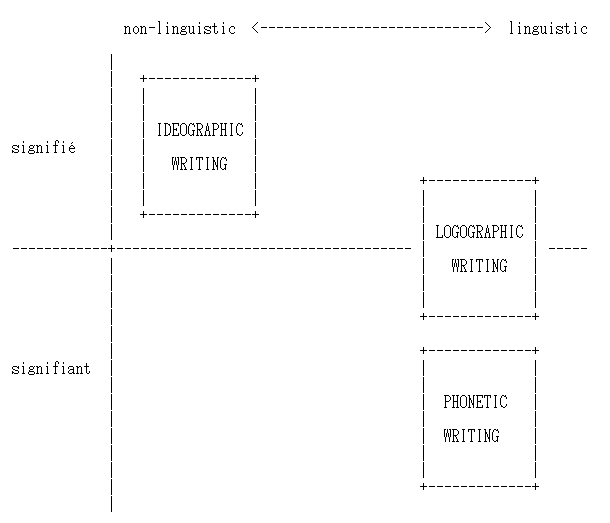「#2341. 表意文字と表語文字」 ([2015-09-24-1]) で文字の類型に触れたが,表意文字 (ideogram) と表語文字 (logogram) に表音文字 (phonogram) を加えると,主要な文字種が出そろう.「#422. 文字の種類」 ([2010-06-23-1]) では各々を簡単に解説した程度だったが,今回はこの3種の文字について,私が目下抱いているところの考え方を披露したい.それは,以下の図にまとめられる.まだ完全ではなく,どこか不満の残る図ではあるのだが,文字の類型のたたき台として示す.

まず,文字の類型において対極にある2種は,表意的表記 (ideographic writing) と表音的表記 (phonetic writing) である.前者は意味を表わし,後者は音を表わす.記号論的に言い換えれば,前者は所記 (signifié) のみを表わし,後者は能記 (signifiant) のみを表わす.図でいえば,縦方向について対極にあるということである.
しかし,表意文字と表音文字は,縦方向だけでなく横縦方向に関しても対置されている.表意文字は,通常,外界のモノ,あるいは言語外の概念を指しており,必ずしも直接に言語単位と結びついていないのに対して,表音文字は,通常,言語音を表わしている.つまり,表意文字は必ずしも言語的ではないが,表音文字は言語的である.
両者の中間的な位置を占めるのが,表語文字である.表語文字は語という明らかに言語的な単位を指しているので,横方向では右の端に位置しているが,縦軸については中間的,あるいは共有的である.語という記号は所記と能記がセットになったものであるから,それを表わす表語文字も,当然ながら所記と能記を表わすことができる.
歴史的には,表意文字から表語文字が発展し,さらに表音文字へと進んだ.しかし,その表音文字とて,それを複数個組み合わせて表わそうとしている言語単位は,音節や音素ではなく,語である.通時的にも共時的にも,言語における文字の役割は,表語に尽きるのではないかと考える.表語は,位置取りからしても,最もバランスのよい文字なのではないか.